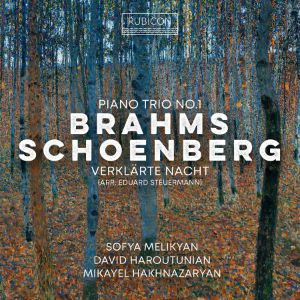
Johannes Brahms (1833-1897)
Piano Trio No 1 in B major, Op 8 (1854, revised version 1889)
Arnold Schoenberg (1874-1951)
Verklärte Nacht [Transfigured Night], Op 4 (arr.1932 for piano trio, Eduard Steuermann)
Sofya Melikyan (piano); David Haroutunian (violin); Mikayel Hakhnazaryan (cello)
rec. 2023, Teatro Principal de Alicante, Spain
Rubicon RCD1195 [63]
Brahms’ Piano Trio No 1 in B major, Op 8 is an early work, completed in 1854 when the fledgling composer was just twenty. He returned to the score some thirty-six years later to make some sizable revisions; only the Scherzo remained essentially the same. This second version of 1889 was premiered in Budapest the following year. It is the one normally played nowadays and is recorded here by this Armenian trio.
In the opening movement, Allegro con brio I savour the adroit playing of Melikyan, Haroutunian and Hakhnazaryan. The temperament of the music is squally and the trio is emphatic, but also performs the contrasting calm and lyrical sections with unfailing sensitivity. Mendelssohn-like in disposition, the Scherzo, marked Allegro molto, is unsettling with nervy outer sections. The trio produces an aching beauty to the Adagio movement and an undertow of reflection. Here one notices Hakhnazaryan’s impressive playing of the prominent cello part. The players are forthright in the Allegro finale, creating a troubled and stormy atmosphere.
Brahms’ piano trios are perennially popular works that have attracted many competing recordings. For the Piano Trio No 1, Op 8 (1889 version), I recommend the 1986 account from the renowned Beaux Arts Trio, recorded at La Chaux-de-Fonds on Philips (The Decca Originals). They create a heartfelt glow and convey a real sense of joy and are extremely successful in the raptly beautiful third movement Adagio. Another worthy recording is from Renaud Capuçon (violin), Gautier Capuçon (cello) and Nicholas Angelich (piano), recorded in 2003 on Virgin Classics. The trio plays with real polish and a level of expression that feels effortless, but this new account can rub shoulders with the finest recordings.
Included on the album is Schoenberg’s outstanding early work Verklärte Nacht (Transfigured Night). This string sextet was written quickly in a burst of creativity in 1899 and for me, it epitomises Austrian Late-Romanticism from Imperial Vienna. It’s a favourite work in concert programmes, largely in the arrangement for string orchestra.
The inspiration behind Verklärte Nacht was Richard Dehmel’s dark poems Weib und Welt (Woman and World) and likely his feelings for his future wife Mathilde Zemlinsky. In a single movement, it’s a programmatic chamber work in five sections that pertain to the five stanzas of Dehmel’s poem. When submitted for performance in Vienna it was rejected on the grounds of “dangerously extreme chromaticism.” It was, however, premiered three years later in Vienna, to some audience uproar.
Schoenberg’s version for string orchestra was premiered in 1917 in Prague, with Alexander von Zemlinsky conducting, a version he revised again in 1943. There is a captivating performance of this conducted by Herbert von Karajan, with the Berliner Philharmoniker in his celebrated 1974 recording on Deutsche Grammophon ‘The Originals’. Played here is the 1932 version for piano trio that was prepared by Eduard Steuermann, who had studied composition with Schoenberg and was soloist in the premieres of both Schoenberg’s Pierrot Lunaire and his piano concerto.
This magnificent score is given an outstanding reading here by this trio, which displays a striking combination of unity, expression, intonation and accuracy, creating an anxious, passionate beauty together with great emotional tension. Throughout, pianist Sofya Melikyan sets the tone with exemplary displays that are models of technical command and insight. Given a performance as successful as this, one wonders why this piano trio version isn’t played more often.
Recording in the Teatro Principal de Alicante, the engineering team has provided clear and well-balanced sound. Andrew Stuart is the author of the helpful booklet essay and Gustav Klimt’s painting Beech Forest (1902) provides the front and back cover art.
The coupling and playing on this album make for a decidedly compelling release.
Michael Cookson
Buying this recording via a link below generates revenue for MWI, which helps the site remain free



















